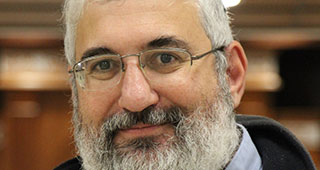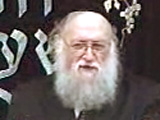Beit Midrash
- Shabbat and Holidays
- Jewish Holidays
- Sukkot
"I have noticed recently that prefab Sukkos come with straps or bars that run along the sides of the sukkah. Could you please explain to me why the manufacturers are now making a more complicated product?"
Question #2: Pergola or sukkah?
"May a pergola or trellis be used to hold the schach of a sukkah?"
Question #3: Going out to a sukkah
"My aunt, who always takes the family out to eat when she visits, will be in town for Sukkos, and she knows that her favorite restaurant has a sukkah for Chol Hamoed. Can we rely on the restaurant's sukkah?"
Answer:
This is the second part of a revised version of an interview I provided to Mishpacha magazine a few years ago. This article covers some of the more common halachic issues and problems one finds regarding sukkah walls. Although I have edited the original article somewhat, I have left the interview structure. A pdf of the original article can be found on RabbiKaganoff.com
Mishpacha:
Why should sukkah walls require a hechsher?
RYK:
Let me first present the basic laws of sukkah walls, and then I will explain what a hechsher on a prefab sukkah should mean.
Many people have learned that since the word sukkah has three letters -- the samech with four sides, the kof with three, and the heih with two and a small yud opposite it -- a sukkah may be kosher with four, three or even two walls as long as there is a bit of a third wall on the third side. Unfortunately, the halacha is not as clear-cut as this vort makes it seem. Although there are situations in which a sukkah is kosher when it has three partial walls that do not run the length or width of the sukkah, the laws pertaining to such a sukkah are extremely complicated, and one should not build such a sukkah without conferring with a halachic authority.
Because of the concern that a partial wall often does not qualify as a proper sukkah wall, the Rama mentions that it is now customary not to build a sukkah with only partially constructed walls, but, instead, to make sure that it has three walls that are the full length or width of the sukkah. 1 Nevertheless, there are situations when this is not practical. I find this situation most common in Eretz Yisroel or in some parts of New York City, where people must assemble their sukkah in a courtyard or porch that has several entrances or is unevenly shaped, so that it is impossible to construct three full walls. I strongly recommend that someone in this situation consult with a competent halachic authority before building the sukkah to ascertain that their plans, indeed, meet the halachic requirements. Then have the rav see the actual sukkah after it is constructed, with enough time before Yom Tov to make any necessary changes. It is a shame to have invested the time and money for a sukkah and then not fulfill the mitzvah because someone was too proud or too busy to check that the sukkah was kosher. (In addition, eating in a sukkah whose kashrus is questionable could entail violating halacha and reciting brochos levatalah.)
Keep your roof near your walls
Furthermore, the law is that the walls of the sukkah must be fairly close to the schach. The horizontal distance between the schach and the three walls must be less than three tefachim (according to some opinions, 24 centimeters or 9.4 inches 2 ), or the sukkah is not kosher. Every year I see sukkahs that, unfortunately, are not kosher because of this problem. Sometimes people build a framework for their sukkah, including walls and schach, but do not realize that the schach must be near the walls. I have also often seen fancy, pergola-like frames built on patios and upon which the schach is placed, but the schach is at too great a distance from the patio walls for the sukkah to be kosher. These sukkahs can almost always be fixed so that they are kosher halachically, but one has to know how to do it properly.
With the wind to my sukkah's back
Here is another common problem -- sukkahs made with walls that are too flimsy. The Gemara teaches that "any partition that cannot withstand a typical wind does not qualify as a partition." 3 The Gemara then notes that this principle seems to be contradicted by a Mishnah that rules that a sukkah may be constructed using trees as its walls, yet trees move in the wind. The Gemara responds that the Mishnah refers to substantive, thick trees that will not move in the wind. The Gemara then asks that even if the tree is strong, the canopy of the tree will certainly be blown by the wind. To this the Gemara responds that the Mishnah must be discussing a case where the tree’s canopy was reinforced so that the wind would not move it.
There are two ways of explaining this section of Gemara:
Some understand that the Gemara invalidates a sukkah only if the wind will blow down the wall or blow apart the materials that constitute the wall such that it now has gaps that invalidate it; but a wall that sways is valid. 4 According to this approach, a cloth-walled sukkah assembled such that its walls are tied properly at the top and bottom is kosher, even though the middle of the "walls" sways considerably in the wind.
However, most authorities rule that the Gemara means that if a typical wind causes noticeable movement to the wall, it is invalid as a sukkah wall. The wording of Rambam and Shulchan Aruch seems to bear out this approach:
"Someone who makes his sukkah among the trees, using them as walls; if they were strong or he tied them until the point that a common wind would not constantly move them, and he filled in between the branches with straw tied in a way that the wind would not sway them, the sukkah is kosher." 5
According to this approach, most prefab sukkos pose a halachic concern, since they are usually made of cloth or plastic walls that blow in the wind. One finds some discussion among authorities as to how much swaying is called too much. Some authorities rule that if one makes the walls very taut, the sukkah is still valid.
Many years ago I was approached by a manufacturer of prefab sukkahs to provide him with a hechsher. His sukkah was indeed made of very thick cloth which, when assembled according to his instructions, was very taut.
Mishpacha: Did you give him a hechsher?
RYK: No, I did not. Some early authorities are concerned about the use of cloth walls for a sukkah, even when they are made very taut, because of concern that they will loosen and then sway in the wind. 6 The same passage of Shulchan Aruch I just quoted cites this opinion. Allow me to quote the Shulchan Aruch’s conclusion:
"Therefore it is improper to make all the walls from linen curtains without sticks, even if one tied them well, because sometimes the ties loosen without anyone realizing it, and now the wall can no longer withstand a typical wind. Someone who wants to use sheets [for his sukkah walls] should weave sticks into his walls within every three tefachim." 7
It seems to me that one should not build a sukkah with any type of cloth walls, unless one reinforces them with something that the wind cannot blow. I presume that the rav who did provide this manufacturer with a hechsher on the sukkah walls felt that one can draw a distinction between thick, strong cloth and the "curtains" and "sheets" mentioned by the Shulchan Aruch. However, I was (and remain) unwilling to provide a hechsher to something that runs counter to the Shulchan Aruch, according to my understanding.
Today, the halachically better quality cloth-walled sukkos come with straps or cords that create halachic walls. Let me explain how this works. There is a halachic principle called lavud, according to which a gap of less than three tefachim (24 centimeters or 9.4 inches) in a wall is treated as if it is actually closed. According to this principle, one can technically build sukkah walls with sticks placed either horizontally or vertically every 24 centimeters along its sides.
If one uses vertical sticks or wires, one needs only to construct "walls" through lavud until they reach a height of ten tefachim (80 centimeters or 31.5 inches), which is technically the minimum height requirement for the walls of a sukkah (see Shulchan Aruch Orach Chayim 630:9). For this reason, the prefab sukkos made with belts or crossbars have them only from the floor until they reach this height.
Mishpacha:
"Rav Kaganoff, could I ask you to address this actual case we were asked: My aunt, who always takes the family out to eat when she visits, will be in town for Sukkos, and she knows that her favorite restaurant has a sukkah for Chol Hamoed. Can we rely on the restaurant's sukkah?"
RYK: Even when the restaurant has a good hechsher, the sukkah assembled often is a cloth-walled type that most authorities invalidate. I have even seen restaurants with excellent hechsherim sporting sukkahs that were not kosher at all. For example, the cloth walls were not secured properly and they billowed upward in the wind, which is not kosher even according to the lenient position mentioned above. Yes, I also find it surprising that the hechsher is assuming responsibility only for the kashrus of the food, but does not get involved in whether the sukkah built by the restaurant is kosher.
Thus, if you want to accept Aunt Shprintzah's wonderful invitation, check in advance how the restaurant sukkah is constructed. It has often happened that I received a phone call from a person at a restaurant trying to figure out what to do, and I have advised him to eat only items that one may eat outside the sukkah.
Conclusion
We all hope to merit performing this beautiful mitzvah in the best way possible. After having davened for a good, sweet new year, the logical continuation is to observe mitzvas sukkah in a halachically correct manner, getting our year off to a wonderful start!
This Shiur is published also at Rabbi Kaganof's site
^ 1.Glosses to Shulchan Aruch, Orach Chayim 630:5
^ 2.There are several opinions how to measure or estimate the length of a tefach in contemporary measurements. I suggest that our readers confer with their rav or posek for direction as to what size to use.
^ 3.Gemara Sukkah 24b
^ 4.Chazon Ish, Orach Chayim 77:6
^ 5.Rambam, Hilchos Sukkah 4:5; Shulchan Aruch, Orach Chayim 630:10
^ 6.Rabbeinu Peretz in his notes to the Sma"k
^ 7.Shulchan Aruch Orach Chayim 630:10. Other authorities who discuss this issue at length include Rabbi Ovadyah Yosef in his Shu"t Yechaveh Daas 3:46.

When You Harvest
Rabbi Yossef Carmel | Tishrei 5785

Tree Tastes Like the Fruit
Rabbi Ari Shvat | Tishrei 5786

All Citizens in Israel
From V’samachta B’chagecha, p. 6
Rabbi Shaul Yisraeli zt"l | 12 Tishrei 5784
























